We last covered Barclays PLC (NYSE:BCS) (OTCPK:BCLYF) in October 2022, arguing that the British bank might benefit from its private banking unit, wealth management activities, and valuation metrics. Fortunately, the bank’s stock price has surged ever since. However, a changing interest rate environment has emerged, prompting me to revise our outlook on the stock.
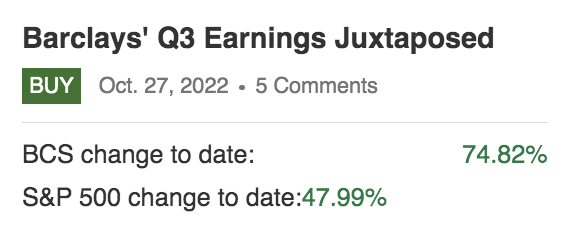
Previous Barclays Analysis (Seeking Alpha)
Without further ado, here is my latest take on Barclays’ prospects.
Operational Review
In my opinion, the best way to determine Barclays’ prospects is to revise its recent half-year and quarterly results while considering the current systematic environment.
Headline
Barclays’ latest results show that it generated £6.3 billion in income during its second quarter, which is noticeably lower than its first-quarter income. The bank’s retail and corporate banking showed weaker numbers than in the previous two quarters. However, its intermediation and underwriting fees held firm.
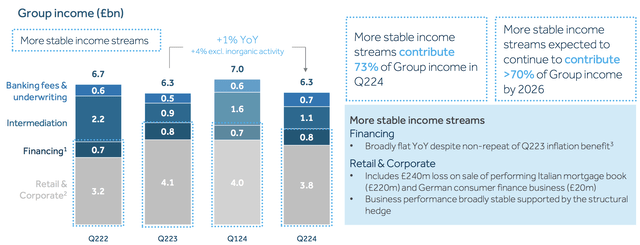
Quarterly Results Time Series (Barclays)
Here is a diagram of Barclays’ segmental return on tangible equity (ROTE) to add context before we proceed to a deeper analysis. For those unaware, ROTE displays segmental utility by illustrating before-income and tax profitability versus tangible equity.
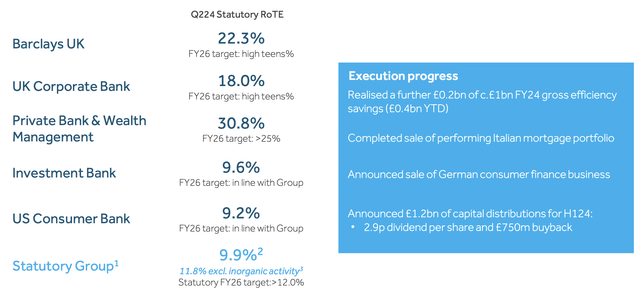
ROTE By Segment (Barclays)
A potential crunch in UK NII?
I believe two material aspects will influence Barclays’ interim trajectory: net interest income from retail [and] corporate banking and investment banking.
As illustrated below, Barclays UK, which is primarily a personal lender and account facilitator, accounts for nearly 60% of the bank’s net interest income. Moreover, UK corporate banking, private banking, and U.S. consumer banking account for most of the rest.
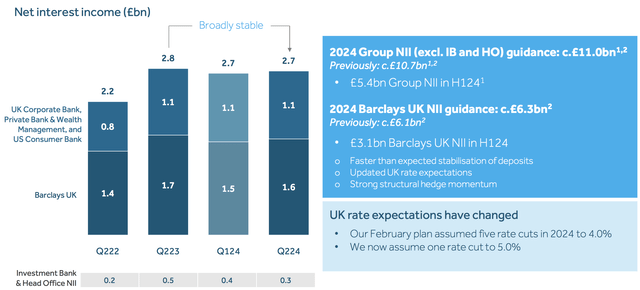
NII (Barclays)
I’m pessimistic about U.K. consumer debt, as credit card missed payments have increased. Although an isolated observation, credit card debt often conveys the general health of household obligations.
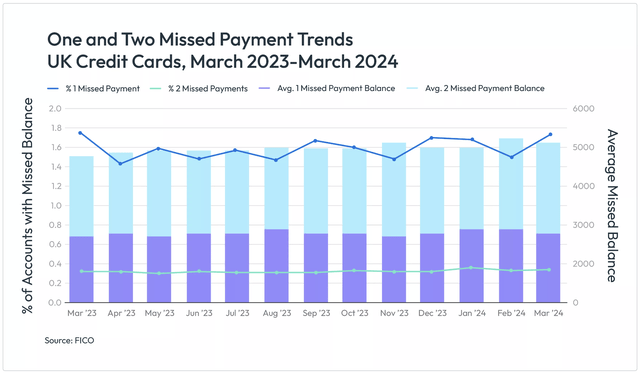
UK Credit Card Trends (FICO Blog)
Furthermore, a Bank of England survey recently discovered that mortgage defaults are anticipated to rise, which I agree with as lower interest rates often introduce higher credit spreads (BoE recently cut interest rates by 25 basis points). About 2.5% of UK mortgages are currently in arrears, and regardless of refinancing possibilities, I won’t be surprised if that number notches up in due course.
To conclude this section, I wanted to look at market-implied credit risk.
The CDS values below illustrate the market’s view of the UK’s credit risk. In my experience, credit spreads can be tight at the top of the economic cycle and widen when interest rates drop when induced by lower economic persistence.
Aside: Here’s a link to the UK’s key economic indicators, supporting my economic persistence argument. I centered my analysis on business confidence, consumer confidence, and GDP growth.

CDS Spreads Are Razor Thin (worldgovenmentbonds.com)
Supportive Investment Banking
Despite observing headwinds related to Barclays’ net interest income, I think the company’s investment banking unit has promise. The unit spans a significant portion of Barclays’ total income and is at a pivotal stage.
The following diagram provides a breakdown of Barclays’ investment banking results; a discussion follows.
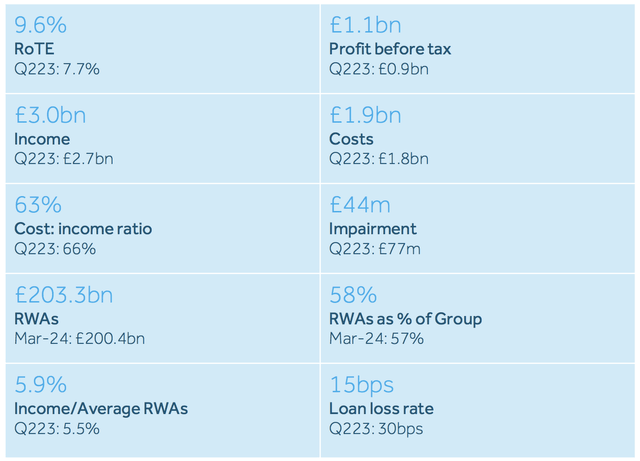
IBD (Barclays)
I see tremendous scope for corporate refinancing amid a pivot in the UK’s and perhaps global interest rates. Furthermore, lower interest rates can contribute to leveraged buyouts through higher capital accessibility.
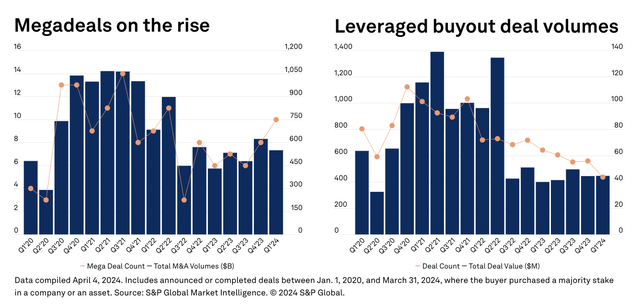
M&A Activity (S&P Global)
Another consideration is the secondary market. Global stock markets are on a solid run, which might prompt primary market activity via higher IPO volumes. Although Ernst and Young suggest that global IPO volumes have decreased by 12% year-over-year in H1, companies might bet on the systematic support from secondary markets to time their listings.
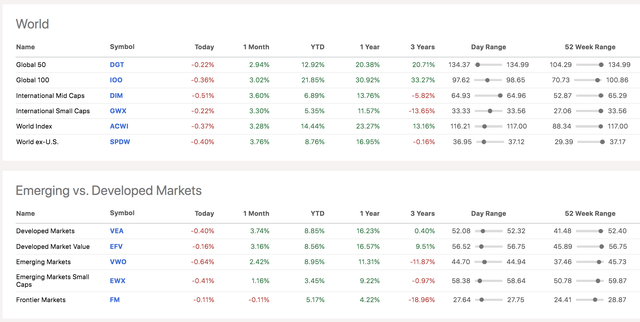
Global Stock Markets (Seeking Alpha)
Lastly, the segment’s cost-to-income ratio has dipped considerably in the past few quarters.
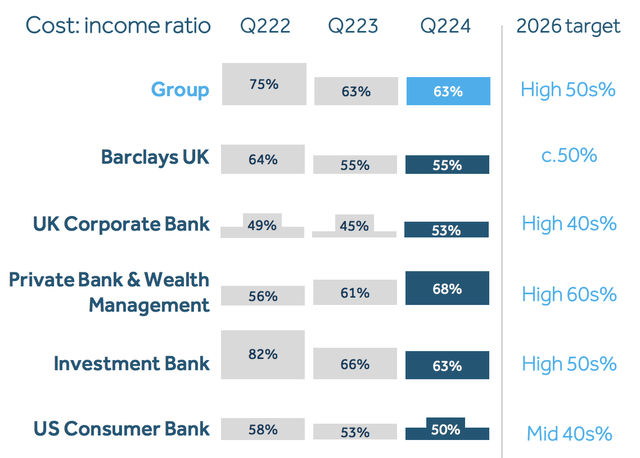
Cost-To-Income (Barclays)
Private Banking & Wealth Management
I’m tremendously excited about private banking and wealth management as a concept. I recently discussed the phenomenon in an article covering Deutsche Bank (DB). However, let me reiterate my optimism.
Private banking and wealth management provide an integrated approach whereby banks leverage their private clientele into wealth management products. Why is this beneficial? It usually allows both segments to target the same end market instead of allocating their marketing budgets toward different markets. Moreover, private banking typically attracts higher-end clients, providing a less cyclical funding source. As such, I deem the approach a secular prospect.
The following diagram communicates Barclays’ private banking and wealth management data. I think the segment’s cost-to-income ratio and ROTE are compelling, and, as already mentioned, secular growth is available.
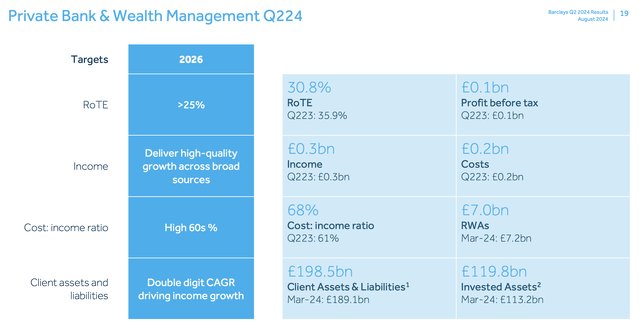
Private Banking and Wealth Management (Barclays)
Here is an expanded view of Barclays’ private banking and wealth management segment. Notice how consistent the segment’s deposit and invested asset growth has been in the past two years, illustrating my secular argument.

Private Banking and Wealth Management (Barclays)
Risk-Weighted Capital Metrics
Investors often emphasize a bank’s risk-weighted capital metrics, which show its stance with regulators and ability to accept risk. Below is a collection of risk metrics, and a discussion follows.
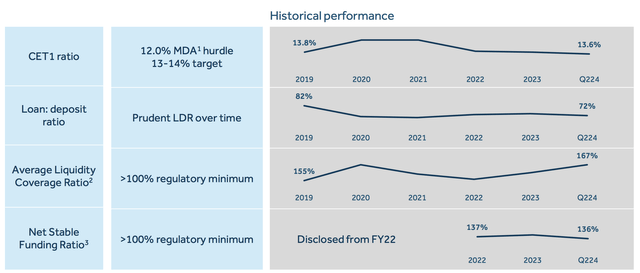
Barclays
A common equity tier 1 ratio, aka CET1, conveys a bank’s liquidity relative to its segmental risk. The CET 1 ratio measures operational and market risk across segments to determine how much capital a bank should maintain to protect against tail risk.
Barclays’ CET 1 of 13.6% is above the regulatory requirement of 4.5%. Moreover, the bank’s liquidity coverage and net stable funding ratios are above 100%, suggesting Barclays is equipped to meet its short and interim liabilities in a financial tail risk event.
In my view, Barclays has solid risk-adjusted metrics, which allow it to onboard additional risk and seek higher returns.
Valuation and Dividends
Continuous Residual Income Model
I used a continuous residual income model to value Barclays’ stock because I wanted to emphasize the bank’s book value. Moreover, the model incorporates the influence of dividends on a bank’s book value.
Although merely a guidepost, the continuous residual income model holds validity and is widely applied by financial analysts. In this instance, the RI model deems Barclays’ stock undervalued, suggesting it could reach $19.9 per share, an approximate 62% increase from its closing price on August 26th, 2024.
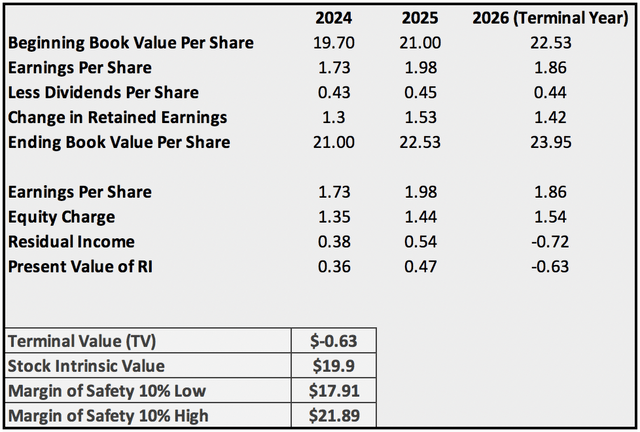
Author’s Work
Herewith are the model’s inputs.
- I used the reciprocal of Barclays’ price-to-book ratio and stock price to set a baseline book value.
- Seeking Alpha’s database was used to find forecasted dividends and earnings-per-share. However, the terminal year was normalized by averaging the values.
- Alpha Spread’s database was utilized to find the equity charge, aka CAPM.
Again, I reiterate that the RI model provides a guidepost. It’s a theoretical concept and not a guarantee of future returns.
Wall Street’s Targets
To cross-check my valuation, I utilized Seeking Alpha’s database to examine Wall Street’s consensus about Barclays’ stock. The average analyst anticipates the stock to recede to $11.80. However, some analysts expect the stock to increase, reaching $14.90.
Wall Street analysts aren’t as bullish about Barclays’ stock as I am. Fundamental, macroeconomic, and other headwinds might be the root cause. Nevertheless, I stand by my opinion about the stock being undervalued. Although the 62% upside predicted earlier might be a stretch, I deem the stock undervalued.

Wall Street BCS Price Targets (Seeking Alpha)
Dividends
To assess its dividend, I compared Barclays to Deutsche Bank, Lloyds (LYG), BNP Paribas (OTCQX:BNPQF), and HSBC (HSBC). This is merely one of many peer groups. However, I believe it holds some validity.

Peers (Seeking Alpha)
A parsimonious observation suggests that better dividend stocks might be on offer. For example, BNP Paribas, HSBC, and Lloyds have higher forward dividend yields than Barclays. Moreover, Barclays pays a semi-annual dividend instead of quarterly, a noteworthy consideration for investors seeking asset-liability management.
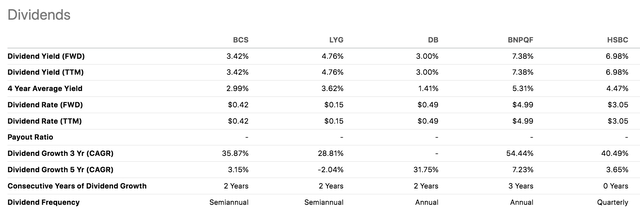
Peers (Seeking Alpha)
I wouldn’t say that Barclays’ dividend is discouraging. In fact, I think its dividend yield and growth rates are compelling. Nevertheless, a peer-based analysis suggests that better income-based opportunities likely exist.
Limitations Of The Analysis
Let’s consolidate a few limitations to avoid biases.
Firstly, I assumed a hard-lined outlook for interest rates and credit spreads. The bond market is highly unpredictable, so my outlook for NII is merely an opinion. In addition, I assumed that lower interest rates would stimulate investment banking activity, which might be an erroneous assumption as economic risk factors can introduce lower primary market activity.
Another consideration is my residual income valuation model. The model translates Barclays’ British Pound into USD over a discrete period. However, currency relationships fluctuate continuously. Thus, I would not take the model at face value.
The Gist Of It
I think Barclays’ stock has room to roam into. Although its net interest income might suffer from macroeconomic headwinds and lower interest rates, key metrics suggest that Barclays’ investment banking unit is set to provide telling results.
Furthermore, Barclays’ private banking and wealth management business provides secular growth possibilities, phasing out cyclical risks from its net interest income activities.
Aside from its fundamental prowess, my residual income valuation model deems the stock undervalued. Therefore, I remain bullish about Barclays’ stock.
Read the full article here
